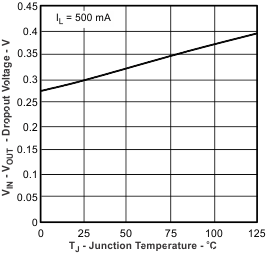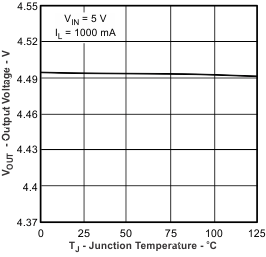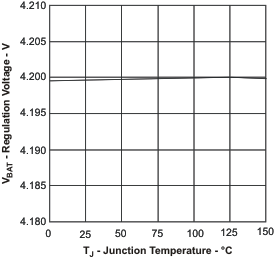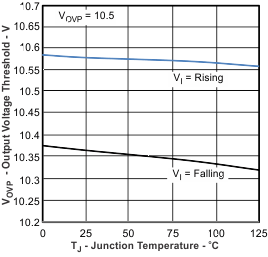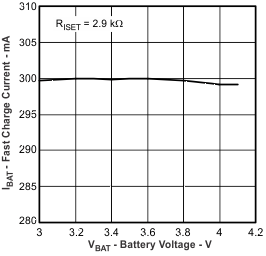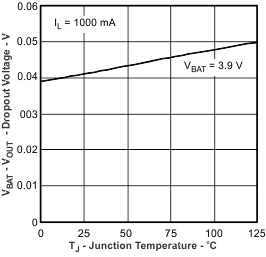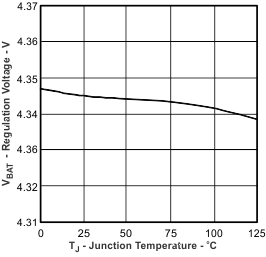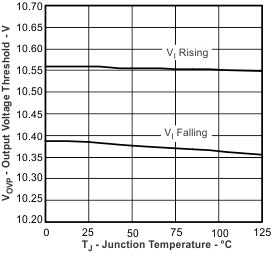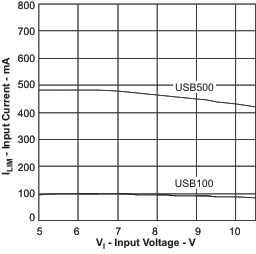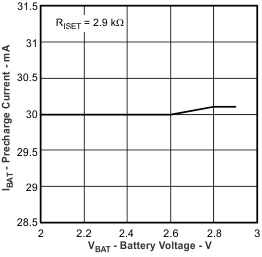ZHCSD66B January 2014 – May 2017
PRODUCTION DATA.
- 1 特性
- 2 应用范围
- 3 说明
- 4 修订历史记录
- 5 Device Comparison Table
- 6 Pin Configuration and Functions
- 7 Specifications
-
8 Detailed Description
- 8.1 Overview
- 8.2 Functional Block Diagram
- 8.3
Feature Description
- 8.3.1 Undervoltage Lockout
- 8.3.2 Power On
- 8.3.3 Power-Path Management
- 8.3.4
Battery Charging
- 8.3.4.1 Charge Current Translator
- 8.3.4.2 Battery Detection and Recharge
- 8.3.4.3 Termination Disable (TD Input, bq24230H)
- 8.3.4.4 Adjustable Termination Threshold (ITERM Input, bq24232H)
- 8.3.4.5 Dynamic Charge Timers (TMR Input)
- 8.3.4.6 Status Indicators (PGOOD, CHG)
- 8.3.4.7 Thermal Regulation and Thermal Shutdown
- 8.3.5 Battery Pack Temperature Monitoring
- 8.4 Device Functional Modes
- 9 Application and Implementation
- 10Power Supply Recommendations
- 11Layout
- 12器件和文档支持
- 13机械、封装和可订购信息
7 Specifications
7.1 Absolute Maximum Ratings(1)
over the 0°C to 125°C operating free-air temperature range (unless otherwise noted)| MIN | MAX | UNIT | |||
|---|---|---|---|---|---|
| VI | Input voltage | IN (with respect to VSS) | –0.3 | 28 | V |
| OUT (with respect to VSS) | –0.3 | 7 | V | ||
| BAT (with respect to VSS) | –0.3 | 5 | V | ||
| EN1, EN2, CE, TS, ISET, PGOOD, CHG, ILIM, TMR, TD, ITERM (with respect to VSS) | –0.3 | 7 | V | ||
| II | Input current | IN | 600 | mA | |
| IO | Output current (continuous) | OUT | 1700 | mA | |
| BAT (Discharge mode) | 1700 | mA | |||
| Output sink current | CHG, PGOOD | 15 | mA | ||
| TJ | Junction temperature | –40 | 150 | °C | |
| Tstg | Storage temperature | –65 | 150 | °C | |
(1) Stresses beyond those listed under absolute maximum ratings may cause permanent damage to the device. These are stress ratings only, and functional operation of the device at these or any other conditions beyond those indicated under Recommended Operating Conditions is not implied. Exposure to absolute-maximum-rated conditions for extended periods may affect device reliability. All voltage values are with respect to the network ground terminal unless otherwise noted.
7.2 ESD Ratings
| VALUE | UNIT | |||
|---|---|---|---|---|
| V(ESD) | Electrostatic discharge | Human body model (HBM), per ANSI/ESDA/JEDEC JS-001(1) | ±2000 | V |
| Charged-device model (CDM), per JEDEC specification JESD22-C101(2) | ±500 | |||
(1) JEDEC document JEP155 states that 500-V HBM allows safe manufacturing with a standard ESD control process. Manufacturing with less than 500-V HBM is possible with the necessary precautions. Pins listed as ±2000 V may actually have higher performance.
(2) JEDEC document JEP157 states that 250-V CDM allows safe manufacturing with a standard ESD control process. Manufacturing with less than 250-V CDM is possible with the necessary precautions. Pins listed as ±500 V may actually have higher performance.
7.3 Recommended Operating Conditions
| MIN | MAX | UNIT | |||
|---|---|---|---|---|---|
| VI | IN voltage range | 4.35 | 26 | V | |
| IN operating voltage range | '230H | 4.35 | 6.4 | V | |
| '232H | 4.35 | 10.2 | |||
| IIN | Input current, IN pin | 500 | mA | ||
| IOUT | Current, OUT pin | 1500 | mA | ||
| IBAT | Current, BAT pin (discharging) | 1500 | mA | ||
| ICHG | Current, BAT pin (charging) | 500 | mA | ||
| TJ | Junction temperature | –40 | 125 | °C | |
| RILIM | Maximum input current programming resistor | 3.1 | 7.8 | kΩ | |
| RISET | Fast-charge current programming resistor | 1.74 | 34.8 | kΩ | |
| RTMR | Timer programming resistor | 18 | 72 | kΩ | |
| RITERM | Termination programming resistor | '232H | 0 | 15 | kΩ |
7.4 Thermal Information
| THERMAL METRIC(1) | bq2423xx | UNIT | |
|---|---|---|---|
| RGT | |||
| 16 PINS | |||
| θJA | Junction-to-ambient thermal resistance | 44.5 | °C/W |
| θJCtop | Junction-to-case (top) thermal resistance | 54.2 | |
| θJB | Junction-to-board thermal resistance | 17.2 | |
| ψJT | Junction-to-top characterization parameter | 1.0 | |
| ψJB | Junction-to-board characterization parameter | 17.1 | |
| θJCbot | Junction-to-case (bottom) thermal resistance | 3.8 | |
(1) For more information about traditional and new thermal metrics, see the IC Package Thermal Metrics application report, SPRA953.
7.5 Electrical Characteristics
over operating free-air temperature range (unless otherwise noted)| PARAMETER | TEST CONDITIONS | MIN | TYP | MAX | UNIT | |
|---|---|---|---|---|---|---|
| INPUT | ||||||
| UVLO | Undervoltage lockout | VIN: 0 V → 4 V | 3.2 | 3.3 | 3.4 | V |
| Vhys(UVLO) | Hysteresis on UVLO | VIN: 4 V → 0 V | 200 | 300 | mV | |
| VIN(DT) | Input power detection threshold | Input power detected when VIN > VBAT + VIN(DT)
VBAT = 3.6 V, VIN: 3.5 V → 4 V |
55 | 95 | 145 | mV |
| Vhys(INDT) | Hysteresis on VIN(DT) | VBAT = 3.6 V, VIN: 4 V → 3.5 V | 20 | mV | ||
| tDGL(PGOOD) | Deglitch time, input power detected status | Time measured from VIN: 0 V → 5 V 1-μs rise time to PGOOD = LO |
2 | ms | ||
| VOVP | Input overvoltage protection threshold | ('230H) VIN: 5 V → 7 V | 6.4 | 6.6 | 6.8 | V |
| ('232H) VIN: 5 V → 11 V | 10.2 | 10.5 | 10.8 | |||
| Vhys(OVP) | Hysteresis on OVP | ('230H) VIN: 7 V → 5V | 110 | mV | ||
| ('232H) VIN: 11 V → 5 V | 175 | |||||
| tDGL(OVP) | Input overvoltage blanking time | 50 | μs | |||
| tREC(OVP) | Input overvoltage recovery time | Time measured from VIN: 11 V → 5 V 1 μs fall time to PGOOD = LO |
2 | ms | ||
| ILIM, ISET SHORT-CIRCUIT TEST | ||||||
| ISC | Current source | VIN > UVLO and VIN > VBAT+VIN(DT) | 1.3 | mA | ||
| VSC | VIN > UVLO and VIN > VBAT+VIN(DT) | 520 | mV | |||
| QUIESCENT CURRENT | ||||||
| IBAT(PDWN) | Sleep current into BAT pin | CE = LO or HI, input power not detected, no load on OUT pin, TJ = 85°C | 6.5 | μA | ||
| IIN(STDBY) | Standby current into IN pin | EN1= HI, EN2=HI, VIN = 6 V, TJ=85°C | 50 | μA | ||
| EN1= HI, EN2=HI, VIN = 10 V, TJ=85°C | 200 | |||||
| ICC | Active supply current, IN pin | CE = LO, VIN = 6 V, no load on OUT pin, VBAT > VBAT(REG), (EN1, EN2) ≠ (HI, HI) |
1.5 | mA | ||
| POWER PATH | ||||||
| VDO(IN-OUT) | VIN – VOUT | VIN = 4.45 V, IIN = 500 mA, VBAT = 4.35 V | 150 | 237.5 | mV | |
| VDO(BAT-OUT) | VBAT – VOUT | IOUT = 500 mA, VIN = 0 V, VBAT > 3 V | 62.5 | mV | ||
| VO(REG) | OUT pin voltage regulation | VIN > VOUT + VDO (IN-OUT) | 4.4 | 4.5 | 4.6 | V |
| IINmax | Maximum input current | EN1 = LO, EN2 = LO | 90 | 95 | 100 | mA |
| EN1 = HI, EN2 = LO | 450 | 475 | 500 | |||
| EN1 = LO, EN2 = HI | KILIM/RILIM | A | ||||
| KILIM | Maximum input current factor | ILIM = 200mA to 500mA | 1380 | 1530 | 1680 | AΩ |
| IINmax | Programmable input current limit range | EN2 = HI, EN1 = LO, RILIM = 3.1 kΩ to 7.8 kΩ | 200 | 500 | mA | |
| VIN-DPM | Input voltage threshold when input current is reduced | EN2 = LO, EN1 = X | 4.35 | 4.50 | 4.63 | V |
| VDPPM | Output voltage threshold when charging current is reduced | VO(REG) – 180 mV | VO(REG) – 100 mV |
VO(REG) – 30 mV | V | |
| VBSUP1 | Enter battery supplement mode | VBAT = 3.6 V, RILIM = 1.5 kΩ, RLOAD = 10 Ω →2 Ω |
VOUT ≤ VBAT –40 mV | V | ||
| VBSUP2 | Exit battery supplement mode | VBAT = 3.6 V, RILIM = 1.5 kΩ, RLOAD = 2 Ω →10 Ω |
VOUT ≥ VBAT–20 mV | V | ||
| VO(SC1) | Output short-circuit detection threshold, power-on | VIN > UVLO and VIN > VBAT + VIN(DT) | 0.8 | 0.9 | 1 | V |
| VO(SC2) | Output short-circuit detection threshold, supplement mode VBAT – VOUT > VO(SC2) indicates short circuit | VIN > UVLO and VIN > VBAT + VIN(DT) | 200 | 250 | 300 | mV |
| tDGL(SC2) | Deglitch time, supplement mode short circuit | 250 | μs | |||
| tREC(SC2) | Recovery time, supplement mode short circuit | 60 | ms | |||
| BATTERY CHARGER | ||||||
| IBAT(SC) | Source current for BAT pin short-circuit detection | VBAT = 1.5 V | 4 | 7.5 | 11 | mA |
| VBAT(SC) | BAT pin short-circuit detection threshold | VBAT rising | 1.6 | 1.8 | 2 | V |
| VBAT(REG) | Battery charge voltage | 4.306 | 4.35 | 4.394 | V | |
| VLOWV | Precharge to fast-charge transition threshold | VIN > UVLO and VIN > VBAT + VIN(DT) | 2.9 | 3 | 3.1 | V |
| tDGL1(LOWV) | Deglitch time on precharge to fast-charge transition | 25 | ms | |||
| tDGL2(LOWV) | Deglitch time on fast-charge to precharge transition | 25 | ms | |||
| ICHG | Battery fast-charge current range | VBAT(REG) > VBAT > VLOWV, VIN = 5 V, CE = LO, EN1 = LO, EN2 = HI | 25 | 500 | mA | |
| Battery fast-charge current | CE = LO, EN1= LO, EN2 = HI, VBAT > VLOWV, VIN = 5 V, IINmax > ICHG, no load on OUT pin, thermal loop and DPM loop not active |
KISET/RISET | A | |||
| KISET | Fast-charge current factor | 25 mA ≤ ICHG ≤ 500 mA | 797 | 870 | 975 | AΩ |
| KPRECHG | Precharge current factor | 2.5 mA ≤ IPRECHG ≤ 50 mA | 70 | 88 | 106 | AΩ |
| ITERM | Termination comparator threshold for internally set termination detection | CE = LO, (EN1,EN2) ≠ (LO,LO), VBAT > VRCH, t < tMAXCH, VIN = 5 V, DPM loop and thermal loop not active |
0.09 x ICHG | 0.1 x ICHG | 0.11 x ICHG | A |
| CE = LO, (EN1,EN2) = (LO,LO), VBAT > VRCH, t < tMAXCH, VIN = 5 V, DPM loop and thermal loop not active |
0.027 x ICHG | 0.033 x ICHG | 0.040 x ICHG | |||
| ITERM | Termination current threshold for programmable termination detection | ITERM = 0% to 50% of ICHG | KITER x RITERM/RISET | A | ||
| IBIAS(ITERM) | Current for external termination-setting resistor | 72 | 75 | 78 | μA | |
| KITERM | K factor for termination detection threshold (externally set) (bq24232H) | CE = LO, (EN1,EN2) ≠ (LO,LO), VBAT > VRCH, t < tMAXCH, VIN = 5 V, DPM loop and thermal loop not active |
0.024 | 0.030 | 0.036 | A |
| CE = LO, (EN1,EN2) = (LO,LO), VBAT > VRCH, t < tMAXCH, VIN = 5 V, DPM loop and thermal loop not active |
0.009 | 0.010 | 0.011 | |||
| tDGL(TERM) | Deglitch time, termination detected | 25 | ms | |||
| VRCH | Recharge detection threshold | VIN > UVLO and VIN > VBAT + VIN(DT) | VBAT(REG) –140 mV | VBAT(REG) –100 mV | VBAT(REG) –60 mV | V |
| tDGL(RCH) | Deglitch time, recharge threshold detected | 62.5 | ms | |||
| tDGL(NO-IN) | Delay time, input power loss to charger turnoff | VBAT = 3.6 V. Time measured from VIN: 5 V → 3 V 1-μs fall time |
20 | ms | ||
| IBAT(DET) | Sink current for battery detection | VBAT=2.5 V | 5 | 7.5 | 10 | mA |
| tDET | Battery detection timer | BAT high or low | 250 | ms | ||
| BATTERY CHARGING TIMERS | ||||||
| tPRECHG | Precharge safety timer value | TMR = floating | 1440 | 1800 | 2160 | s |
| tMAXCHG | Charge safety timer value | TMR = floating | 14400 | 18000 | 21600 | s |
| tPRECHG | Precharge safety timer value | 18 kΩ < RTMR < 72 kΩ | RTMR × KTMR | s | ||
| tMAXCHG | Charge safety timer value | 18 kΩ < RTMR < 72 kΩ | 10 × RTMR × KTMR | s | ||
| KTMR | Timer factor | 30 | 40 | 50 | s/kΩ | |
| BATTERY-PACK NTC MONITOR(1) | ||||||
| INTC | NTC bias current | VIN > UVLO and VIN > VBAT + VIN(DT) | 72 | 75 | 78 | μA |
| VHOT | High-temperature trip point | Battery charging, VTS Falling | 270 | 300 | 330 | mV |
| VHYS(HOT) | Hysteresis on high trip point | Battery charging, VTS Rising from VHOT | 30 | mV | ||
| VCOLD | Low-temperature trip point | Battery charging, VTS Rising | 2000 | 2100 | 2200 | mV |
| VHYS(COLD) | Hysteresis on low trip point | Battery charging, VTS Falling from VCOLD | 300 | mV | ||
| tDGL(TS) | Deglitch time, pack temperature fault detection | Battery charging, VTS Falling | 50 | ms | ||
| VDIS(TS) | TS function disable threshold | TS unconnected (applies with TD pin on bq24230H) | VIN-200 mV | V | ||
| THERMAL REGULATION | ||||||
| TJ(REG) | Temperature regulation limit | 125 | °C | |||
| TJ(OFF) | Thermal shutdown temperature | TJ rising | 155 | °C | ||
| TJ(OFF-HYS) | Thermal shutdown hysteresis | 20 | °C | |||
| LOGIC LEVELS ON EN1, EN2, CE, TD | ||||||
| VIL | Logic LOW input voltage | 0 | 0.4 | V | ||
| VIH | Logic HIGH input voltage | 1.4 | 6.0 | V | ||
| IIL | Input sink current | VIL = 0 V | 1 | μA | ||
| IIH | Input source current | VIH = 1.4 V | 10 | μA | ||
| LOGIC LEVELS ON PGOOD, CHG | ||||||
| VOL | Output LOW voltage | ISINK = 5 mA | 0.4 | V | ||
(1) These numbers set trip points of 0°C and 50°C while charging, with 3°C hysteresis on the trip points, with a Vishay Type 2 curve NTC with an R25 of 10 kΩ.
7.6 Typical Characteristics
Typical Application Circuit, EN1 = 0, EN2 = 1, TA = 25°C, unless otherwise noted.